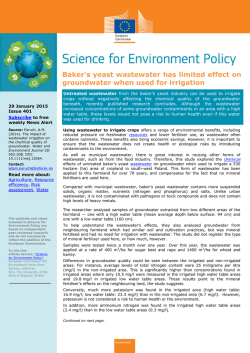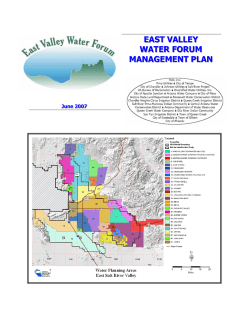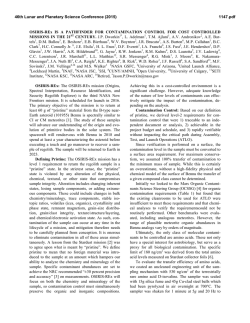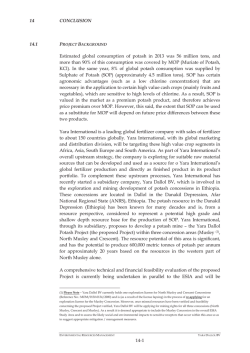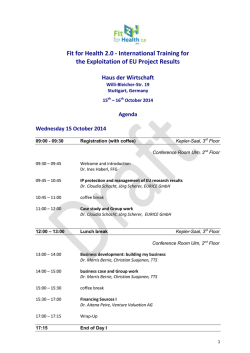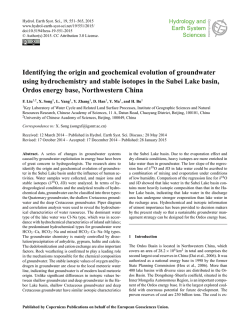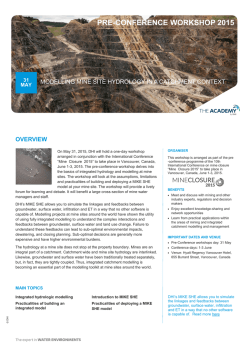
Option Prices for Groundwater Protection
I
.,...
JOURNAL OF ENVIRONMENTAL ECONOMlCS AND MANAGEMENT
15, 475-487 (1988)
Option Prices for Groundwater Protection
STEVEN
F.
EDWARDS1
Marine Policy Center, Woods Hole Oceanographic Institution, Woods Hole, Massachusetts 02543
Received March 31, 1987; revised September 17, 1987
This paper reports results from a contingent valuation study of households' willingness-topay to prevent uncertain, future nitrate contamination of a potable supply of groundwater.
The functional form of the corresponding logit model is derived from utility maximiZation
theory. Probability of future demand, change in the probability of future supply, and an
attitudinal score for interests in the well-being of future generations are significant, positive
determinants of option prices. Several implications of these results for aquifer management
policy are highlighted. co 1988 Academic Press. Inc.
• I. INTRODUCTION
-~.
'I
1;-l
In 1983, Clifford Russell, then chairman of the President's subcommittee on
economic research needs relevant to improved drinking water quality, asked the
pointed question, "Do prospective benefits of this or that standard justify the ·
anticipated costs of meeting it?" [19, p. 6]. His question emphasized the need to
improve our "primitive knowledge" of the benefits of potable water in order to
carry out efficiency analyses of public water quality policies. Although recent
benefits estimates are now available, they tend to be partial and indirect, such as
health benefits derived from dose-response relationships [21, 22] and current,
certain-use benefits which are assumed a priori to be at least as great as the remedial
costs of mitigating groundwater contamination [17, 18]. In contrast, this paper
reports on direct estimates of the total economic value of potable water, including
personal use and bequest values, under conditions of supply and demand uncertainty. Specifically, the contingent valuation method was used to collect data on
option prices to protect a "sole source" aquifer from uncertain, future nitrate
contamination. 2
Recently, the U.S. Geological Survey emphasized their concern about potential
nitrate contamination of aquifers throughout the United States [13]. Fertilizer and
sewage from human and livestock populations are the principal sources of nitrate in
groundwater. Although nitrate itself is relatively nontoxic, it is reduced by intestinal
bacteria to nitrite, a hazardous substance. Nitrate concentrations in drinking water
above EPA's health standard of 10 parts per million (ppm) can cause infant
1
Present address: National Marine Fisheries Service, Northeast Fisheries Center, Woods Hole, MA
02543. Financial support was provided by the J. N. Pew, Jr. Charitable Trust through the Woods Hole
Oceanographic Institution's Marine Policy Center, the U.S. Geological Survey, DOI, under award
Number 14-08-0001-G1404, and the DOC, NOAA, National Sea Grant Program. The contents do not
necessarily represent the policy of the U.S. Geological Survey and should not assume endorsement by the
Federal government. Constructive comments by James Opaluch, Robert Raucher, and an anonymous
reviewer are gratefully acknowledged.
2
EPA designates a "sole source" status to aquifers which supply regional populations with their only
source of drinking water and meet other criteria.
475
0095-0696/88 $3.00
Copyright .o 1988 by Academic Press. Inc.
All rights o( reproduction in any Corm reserved.
476
STEVEN F. EDWARDS
;
I
1
i
!
FIG. 1.
Study site, Cape Cod, Massachusetts.
mortality (methemoglobinemia). In addition, long exposure to nitrate is a suspected
cause of cancer.
The potential for nitrate contamination is of particular concern to coastal areas
like Cape Cod, Massachusetts (Fig. 1), where the sewage of a rapidly growing
population is disposed alffiost directly into the aquifer via septic tanks and shallow
drain fields. On Cape Cod, nitrate levels are steadily increasing toward the 10 ppm
health standard and will continue to increase with population size unless town and
county governments alter land and water use patterns [16]. Indeed, these governments and the state recently initiated work on a regional aquifer management plan
for the entire Cape, hoping tg avoid problems already faced by other coastal regions
such as Long Island, New York. Various options are being considered, including
population growth control through down-zoning and land aquisition, sewage treatment, offshore disposal of treated sewage, on-site denitrification systems, and spray
irrigation. And although the task force is only groping toward a cost assessment of
specific management options it has even less knowledge of the public's total
willingness-to-pay to prevent uncertain, future contamination of the aquifer.
Section II discusses and describes the contingent valuation survey which uses a
binary choice format to elicit option prices from households. Section III both
derives a logit model that is consistent with the binary choice format and utility
maximizing choice under conditions of supply and demand uncertainties and
presents results of the logit estimation. Concluding remarks are offered in
Section IV.
OPTION PRICES FOR GROUNDWATER
477
II. SURVEY METHODOLOGY
The contingent valuation method was used to elicit a household's total maximum
willingness-to-pay to prevent uncertain nitrate contamination of Cape Cod's sole
source aquifer. Several years of study have established the contingent valuation
method as a valid means of estimating use values of environmental resources when
the contingent market is designed to control and test for various response biases [3]
and when certain "reference operating conditions" are satisfied or nearly satisfied
[5]. In addition, total valuations which include nonuse values such as "bequest
value" cannot be ascertained from indirect methods that rely on revealed preferences. Thus, the contingent valuation method can also be one's only alternative for
nonuse valuations. Finally, the contingent valuation method facilitates the collection
of option price data for uncertain, future reductions in environmental resources and
thereby provides an opportunity to test the effects of supply and demand uncertainties under somewhat controlled, experimental conditions. This opportunity is important because uncertainty about future contamination characterizes the nitrate problem in Cape Cod's aquifer and in many other aquifers throughout the country [13].
Also, option price is an appropriate measure of economic value for applied policy
research on uncertainty [1, 4].
The contingent market section of the questionnaire consisted of several parts.
First, households were asked to evaluate the importance to them of several types of
benefits associated with potable groundwater. The list of benefits included wanting
a cost-effective supply of water for personal use and protecting groundwater for use
by future generations, but excluded direct health risks. The exclusion of health risks
was appropriate in this case because the state and county systematically ·monitor
nitrate levels in each of the public wells in order to prevent dangerous exposures to
nitrate. This fact was made clear to households by stating that, "Health effects are
not listed because water quality is being monitored to protect us from using
contaminated water." Thus, whereas households were asked to value a potable,
healthy water resource, health risks should not have been a consideration. 3
Ten versions of the questionnaire posited disparate information just above the
valuation question on the following factors: (a) the year of expected future contamination (5, 10, 20, and 40 years in the future); (b) the probability of nitrate
contamination without a regional aquifer management plan given a 5-year time
horizon (100, 75, 50, and 25%); (c) the probability of <:ontarnination with a
management plan given a 5-year time horizon (0 and 25%); and (d) the price of
bottled water. 4 Based on the particular time horizon received by respondents, they
indicated the likelihood that they would be living on Cape Cod at the t~~, of
3
0f course, some households may have included the avoidance of health risks in their valuations,
despite being instructed not to. In particular, the water quality of private wells is not monitored by
governments, although households can have their water tested for free. (More than 2000 households on
Cape Cod have had their water tested.) Still other respondents may question the reliability of the
monitoring program. However, only 11% of the respondents have private wells. Furthermore, no one
questioned the effectiveness of the monitoring program even though respondents were invited and given
ample space to make additional comments on the last page of the questionnaire-space they used to
voice other points of view. Although this evidence is admittedly circumstantial, it does not suggest that
· the valuation of health risks was prevalent.
4
The price of bottled water was not a significant determinant of the probability of willingness-to-pay.
Similarly, and as reported by Brookshire eta/. (4) in regression results, the future year of expected impact
was not a significant determinant either. These results are not reported in Section III.
478
STEVEN F. EDWARDS
expected contamination. Possible responses, which ranged from "yes, definitely (100
percent certain)" to "no, definitely not (0 percent chance)" with intervening answers
clearly associated with 75, 50, and 25% probabilities, provided subjective information on demand uncertainty for personal use. The versions corresponding to factors
(b) and (c) assigned supply uncertainties. Unfortunately, funding constraints prohibited a larger factorial design with additional information on the probability of
contamination with management or on the costs of other mitigation policies.
Consequently, other interesting issues concerning the effects of more detailed risk
changes [23] and of mitigation costs on willingness-to-pay cannot be answered by
this single study.
The valuation question was the binary choice type that Richard Bishop and his
students introduced and refined (e.g., [2, 3]). This discrete, yes/no format appears to
elicit more valid responses than open-ended requests or bidding games. Notably,
preliminary evidence from Boyle and Bishop's [3] Wisconsin Sandhill study suggests
that there is no significant difference between valuations collected from a hypothetical market using binary choice questions and from actual cash transactions. Accordingly, the contingent market in this nitrate study contained suggested annual
payments to prevent future contamination that ranged from $10 to $20oo: These
suggested payments and their distribution were based on open-ended statements of
willingness-to-pay collected from a pilot study of 200 households. Following the
valuation question, respondents explained why they possibly skipped the valuation,
including reasons for protests.
The pilot study also allowed testing for the potential effects of diff.erent vehicles
on willingness-to-pay. Three separate questionnaires described a bond (i.e., public
referendum) vehicle, a contribution vehicle, and higher water bills, while a fourth
version asked for willingness-to-pay without describing a vehicle. x2 analyses of the
number of respondents (x 2 = 0.67 with 3 degrees of freedom) and of the number of
protests to the payment vehicle by respondents (x 2 = 4.33 with 3 degrees of
freedom) did not reject the null hypotheses of no effects. As a result, the bond
vehicle was selected as the payment mechanism in order to satisfy "reference
operating conditions" [5). Although households are familiar with the market-like
experience of paying water bills, Cape Codders also have substantial experience in
voting on (or choosing not to vote on) bond issues for environmental protection.
This experience augments familiarity with the water resource with issues surround~
ing groundwater quality has discussed at length and frequently by the p.ews media.
The design and impiementation of the survey followed Oilman's [7] "to.tal design
method" for mail questionnaires, including the use of three follow-ups. One thousand households were selected at random from the telephone book using interval
sampling with a random start. In tum, the households were assigned at random to
the 10 versions. The telephone book was the most representative sampling frame for
the target population of renters and resident and nonresident property owners.
However, it was necessary to telephone each household in order to verify mailing
addresses.
Seventy-eight and one-half percent of the sample returned a questionnaire. of
which 585 respondents (i.e., 58.5% of the sample) provided sufficient information
for analysis. The remaining respondents skipped questions pertaining to income,
demand probability, attitudes, and/or valuation. Of those refusing to answer the
valuation question, only 43 households (4.3% of the sample) protested the method of
payment while others' reasons included needing more information before answering
I
iI
OPTION PRICES FOR GROUNDWATER
479
the question (91 respondents) and refusing to place a monetary value on groundwater (36 respondents).
Ill. OPTION PRICE ANALYSIS
Theoretical Model
Subsequent to Bishop et al.'s [2] initial work, logit models have been used
increasingly to analyze binary responses to contingent valuation questions, although ·
there is some disagreement as to how to specify the particular functional form of the·
model [2, 12, 20]. This study adopted Hanemann's [12] axiomatic approach whereby
the logit model was derived from a utility maximizing model of household choice.
Accordingly, suppose that an individual derives personal utility from a Hicksian
commodity (X), water use (W), and knowledge that groundwater will remain
potable for use by future generations (G) such that
U = b1 ·In X+ c1 ·In W
'••"
+ d 1 ·G.
(1)
The parameters b, c, and d are functions of the individual's attitudes. To represent
concern about the well-being of future generations, G = 0 when nitrate concentration exceeds EPA's health limit of 10 ppm, and G = 1 when potability is maintained
for future generations. 5 The budget constraint corresponding to this utility model is
M= X+P· W,
(2)
where X is a numeraire good and P is the relative price of water.
The bequest argument, G, is treated as a pure public good and, therefore, is not a
choice variable for the individual. Hence, maximization of Eq. (1) with respect to X
and W and subject to constraint (2) yields the following indirect utility function6 :
V = U[M, P, G)= a 1
+ b2 ·In M + c2 ·In P + d 1 ·G.
(3)
Since Hanemann [12] already explicated a practical, utility-theoretic procedure
for specifying the functional form of a logit mode(and for deriving corresponding
money measures for welfare, the presentation in this paper will be brief. The
probability that an individual is willing to pay $A to protect groundwater quality
corresponds to
Pr =
[1 + ljexp(~V}] -l,
(4}
5
Similar to Hanemann's (12] representation of hunting as a binary variable, this utility model uses the
simplifying assumption that the bequest good either exists (G = 1) or does not (G = 0). However, it is
conceivable that G could have different levels. For example, G could be indexed to nitrate concentrations
in the aquifer. Nevenheless, the measurement of bequest goods is in a formative stage of development
and is not explored further in this paper.
6
The derivations for equations in this section are available from the author.
-~
480
STEVEN F. EDWARDS
where
(Sa)
PL is the current, low price of muncipal water, and PH is the higher price of
drinking water when the aquifer is contaminated (e.g., bottled water). An equivalent
variation measure of welfare corresponding to LlV can then be derived by setting Eq.
(Sa) equal to zero and solving for A. Using Eq. (3),
(Sb)
and equivalent variation corresponds to
(6)
Next consider the effects of supply and demand uncertainties on the functional
form of the logit model and on the equation for equivalent variation. First consider
the four cases of supply uncertainty already developed by Freeman [10] and
extended by Plummer [1S] and assume for now that household demands for
groundwater are certain. 7 Without an aquifer management plan, the probability that
groundwater will not be contaminated with nitrate (i.e., that groundwater will be
supplied at its present low cost) is 0 ~ q2 ~ 1 and expected utility is
(7a)
where (1 - q 2 ) is the probability that groundwater becomes contaminated. However, with a regional aquifer management plan the probability of supply increases to
r2 > q 2 and the expected value of utility becomes
where OP is option price, or the constant amount that a household would be willing
to pay annually for a particular management strategy, and (1 - r2 ) is the probability that groundwater becomes contaminated even with an aquifer management
program for protection. 8
Next introduce demand uncertainty l:>ut only for personal use value. Assume that
income and prices between states of the world are known with certainty but that
preferences are state-dependent. Recalling that the indirect utility function is
separable in M, P, and G,
EN= (1 - p 2 )
•
V[M, PL]
+p2 · ((1- q2) · V[M, PH] + q 2 · V[M, PL]]
+ (1 7
q2 )
•
V(O] + q2 • V[1]
(8a)
The probability that contamination wiU be detected is a further consideration (18). As mentioned in
Section II, however, the state monitors nitrate concentrations in the aquifer closely. Thus, it is assumed
that the probability of detection is equ<).i to 1.
8
Gallagher and Smith [11) also studied the effect of supply uncertainty on the valuation of
environmental resources. However, unlike in their study, this study adopts Freeman's [10) and Plummer's
(15) assumption of no contingent claims markets.
OPTION PRICES FOR GROUNDWATER
481
and
£0 =
(1 ....:. p 2 )
•
V[M- OP, PL]
V[M- OP, PH] + r2 • V[M- OP, PL]]
V[O] + r 2 • V[1],
+P2 · [(1- r2 )
+(1-
r2 )
•
•
(8b)
where the probability of future demand is 0 ~ P2 ~ 1 and (1 - P2) is the probablity
that demand will be zero. 9 Applying these results to Eq. (3) yields
where c3 = 2 · c2 • ln(PJPH), and ln(PJPH) are assumeq to be constant for all
individuals in the region.
In order to assess the effects of attitudes about groundwater protection on the
probability of payment by different individuals, Eq. (9a) was modified such that
where c3 = c4 • L and d 1 = d 2 ·B. L and B are one-dimensional Likert scales for
attitudes about the importance of protecting groundwater as a cost-effective source
of water for drinking and cooking (L) and the importance of bequesting clean
groundwater for use by future generations (B). Although more complex scoring is
possible, integer scores from 1 to 5 are generally adequate to discriminate levels of
attitudes [14]. In this study, the values for L and B increase from 1 for "not
important" to 5 for "very important." 1 Finally, option price can be derived by
transposing Eq. (9b) for OP:
°
Results
Table I shows results from the maximum likelihood estimation of the logit model
corresponding to specification (9b ). 11 The coefficients have the expected sign and
are statistically significant. The first regressor is the combined effect of income and
~e cost of groundwater protection on net benefits. The second regressor represents
The probability of futur~ demand (p2 ) and the probability that groundwater will not become
contaminated with nitrate are arguably interdependent. For example, the decision to continue living on
Cape Cod could be affected by whether groundwater remains potable. This complicating possibility is
not treated here.
10
Strictly speaking, the Likert 'scales are ordinal. Nevertheless, Likert scales have been tested by social
scientists in related fields and are believed to adequately represen~ the strength of attitudes and beliefs
[12). Possible nonlinearities introduced by these scales were not tested due to the axiomatic way that the
logit model was derived.
11
As explained in Section II, it was not possible to vary the probability of groundwater contamination
with management beyond r2 = 1 and r2 = 0.75. However, a model with Eq. (9b)'s specification plus a
dummy variable for versions with r2 = 0. 75 was estimated. The results show that option price decreases
when r2 • 0.75, although the effect was not statistically significant. See Smith and Desvousges [23) for a
broader empirical analysis of uncertainty.
9
482
STEVEN F. EDWARDS
TABLE I
Logit Analysis of Groundwater Protection°
Regressor
Coefficient
t ratio
112.82
8.16h
(1) Income effect
ln(1 - A/M)
(2) Bequest effect
(rl - ql) . 8
(3) Personal use effect
P2 · (rl - ql) · L
n = 585
xl = 444.5sb
0.514
8.08h
0.224
2.24c
0
logit model is for the probability of paying the stated
amount, $A. See Section III for the derivation of the model
specification (Theoretical Model) and interpretation of regressors (Results).
bSignificant at the 0.001 level of confidence.
<significant at the Q.025 level of confidence.
,.
···'l''
TABLE II
Descriptive Statistics of Variables Used to Estimate logit Model
Variable
Mean
Minimum
Maximum
Standard deviation
Income, M
Scale for costeffective supply, L
Probability of
future demand, p2
Bequest scale, 8
ln(1- OP/M)
P2 · L · (rl - ql)
8. (rl - ql)
55,413
7000
750,000
75,893
3.7
0.7
4.6
-0.009
2.09
3.85
1
0
1
.:._0.138
0
0.75
5
1
5
-0.00008
5
5
1.21
0.31
0.59
0.015
1.384
1.278
concern for future generations (B) weighted by the increase in the probability of
future groundwater supply (r2 - q2 ). Finally, the third regressor represents personal
interest in minimizing the cost of potable water ( L) weighted by both the increase
in probability of future supply (r2 - q2 ) and the probability of future demand ( Pz).
The data used to estimate the logit model are described in Table II.
Unlike. in other studies of natural resource benefits where income was either an
insignificant regressor in the logit model [2] or its coefficient had an unexpected sign
[6], income had a strong and positive effect on the probability of paying for
groundwater protection in this study. 12 For this particular functional structure,
12
In a separate, linear model where income, the suggested payment, uncertainties, and attitudes were
specified additively, the coefficient on income was positive, significant, and robust. The coefficient on the
suggested payment was negative and also significant and robust. However, the additive model predicts
implausibly that option price is greater than zero when the probability of fu~ure demand is zero ( p 2 = 0)
and the increase in the probability of future supply is zero (r2 - q2 = 0). Thus, in addition to the
possible advantage of deriving utility-theoretic measures of surplus, Hanemann's [12) recommended
procedure for contingent valuation experiments with binary response questions avoids this counterintuitive result.
483
OPTION PRICES FOR GROUNDWATER
$1,800
a
$i,350
450
;fjl:;'::~.
·.,
......·.r:
0~-----,------.-----~------.
0.00
0.25
0.50
0.75
1.00
Increase In Probability Of Supply (rz-q2 )
FIG. 2. Option prices for groundwater protection. Probability of future demand (p 2 ) is (a) 1, (b)
0.75, (c) 0.50, (d) 0.25, and (e) 0.00.
l
option price is predicted to increase linearly with income. The percentage increase
ranges from 0% of income when either groundwater will remain potable without
management (i.e., q2 = 1) or there is no increase in the probability of supply to
about 3.5% of income when the aquifer management plan will avert certain
contamination (r2 - q2 = 1) for an individual with certain future use (p 2 = 1) and
with attitudinal scales at their highest values.
The effects of the demand and supply uncertainties and of the bequest motivation
on estimates of option price are illustrated in Figs. 2 and 3 for a hypothetical
household with average respondent traits described in Table II. Each curve in Fig. 2
shows the strong effect of a net increase in the probability of supply on option price.
In these examples, option price ranges from $0 when a management plan does not
increase the probability of supply to $1623 when the probability of supply is
increased from 0.0 to 1.0. These curves also illustrate how option price declines
when the probability of future demand for groundwater on Cape Cod decreases.
This decrease applies to households who are uncertain about how long they will live
on Cape Cod and, therefore, possibly use groundwater from the aquifer. For
example, a reduction in the probability of demand (P2) from 1.0 (curve a) to 0.5
(curve c) is predicted to reduce option price by about 15%, ceteris paribus.
Also of special 4tterest is the relative influence of the bequest attitude on option
price. The change in the probability of future supply is held constant along each
curve in Fig. 3. Along a single curve, option prices predicted by model (10) almost
triple as the bequest scale increases from the value 1 ("not important") to the value
5 ("very important"). The influence of the bequest attitude on option price also
increases as the change in the probability of supply increases. For example, the
range in option prices along curve d in Fig. 3 where the increase in the probability
--- -------,
484
STEVEN F. EDWARDS
of future supply is only 0.25 is $248 whereas the range in option prices along curve a
where the increase in the probability of future supply is 1.0 is $975.
Even households with a zero probability of future demand for groundwater on
Cape Cod have positive option prices. This benefit is attributable exclusively to the
bequest motivation. Curve e in Fig. 2 illustrates one example for a household with
average respondent traits. As described by Eq. (10) for option price, curves a, b, c,
and d comprise bequest value that is traced by curve e, plus the combined effect of
wanting a cost-effective supply of water and of the probability of future demand
(i.e., c4 • p 2 • L ). Based on this comparison alone, 70% (curve a) to 90% (curve d) of
total option price is attributable to bequest value, the remainder being due to
personal use values. Of course, these percentages would change for different values
of the attitudinal scales.
Figure 2 reveals another interesting and possibly surprising result concerning the
components of option prices for groundwater protection. Although probably not
apparent to the reader's naked eye, the curves in Fig. 2 are slightly concave with
respect to the ( r2 - q2 ) axis. This relationship suggests that option values are
positive. That is, option price is by definition the sum of the expected value of
consumer surplus and option value. Graphically, the expected value of consumer
surplus increases linearly from $0 to its maximum where the increase in the
probability of future supply ( r2 - q2 ) is equal to 1 (i.e., where the probabilities of
future supply both with and without the management plan are not uncertain). Thus,
the slightly concave option price curves that lie above the lines for the expected
value of consumer surplus suggest positive but very small option values. In relative
terms, option values associated with Fig. 2 are 1% or less of option price depending
on the increase in the probability of supply. 13
As mentioned previously, the aquifer management plan for Cape Cod is in its
formative stages. Unfortunately, the county government has not contracted a cost
analysis of possible management options, nor have the probabilities of nitrate
contamination for recharge areas surrounding public wells ( q2 ) been determined by
hydrogeologists. Consequently, it is impossible at this time to estimate the efficiency
of aquifer management for Cape Cod. Nevertheless, the range of possible aggregate
benefits is of interest. Two ca.,es should come close to bounding the range of
possible values. In Case I, nonrespondents to the survey (21.5% of the sample) are
assumed to place zero value on the potability of the aquifer. In contrast, nonrespondents are assumed to have preferences similar to respondents in Case 11. 14 In both
cases, the average values of traits characterizing the respondents are used to describe
those who value potable groundwater.
The present value of aggregate benefits per 1000 households is reported in Table
III. The projections, which correspond to a 30-year time series of option prices
13
For comparison, option values derived from an identically specified probit model
Pr {individual willing to pay} = 61.31 ·ln(1- A/M)
(tstatistic)
(9.16)
+0.299 · (r2
(8.89)
-
q2 )
•
B + 0.121 · p 2 • (r2
(2.30)
-
q2 )
·
L
were larger than those derived from logit but still less than 2% of option price.
14
Tbese assumptions ignore possible nonrespondent and selection biases (8]. The calculations only
serve as likely bounds for aggregate benefits.
485
OPTION PRICES FOR GROUNDWATER
$1,600
$1,200
<l>
-~
Q:
c::
800
.<:l
.;::
~
400
2
3
4
Value Of Bequest Scale
FIG. 3.
5
Option prices for groundwater protection. Values for the increase in probability of supply
(r2 - q 2 ) are (a) 1, (b) 0.75, (c) 0.5, and (d) 0.25.
TABLE III
Present Value of Aggregate Benefits per 1000 Householdsa
Increase in probability
of supply (r2 - q2 )
(1.00
(1.00
(1.00
(1.00
-
0.75)
0.50)
0.25)
0.00)
= 0.25
=
=
=
0.50
0.75
1.00
Case I: Nonrespondents do
not value the aquifer
($million)
Case II: Nonrespondents
and respondents are
identical($ million)
4.93
9.81
14.67
12.50
19.51
24.85
6.28
18.69
aPresent value= n OP[1 - (1 + 0.04)- 30 )/0.04 where n = 1000 households; OP is option
price for the representative household, 0.04 is the discount rate, and 30 years is the time horizon.
discounted at 4%, increase from nearly $5 million under Case I when the probability
of supply increases by only 0.25 from q2 = 0.75 to r2 = 1.0 to nearly $25 million
under Case II when the probability of supply increases from 0.0 to 1.0 with a
management plan.
IV. CONCLUDING REMARKS
This paper tested for the effects of demand and supply uncertamties and the
strength of a bequest attitude on household willingness-to-pay to protect groundwater quality from uncertain, future nitrate contamination. These results complement
recent cost analyses of aquifer contamination [17, 18] with estimates of option prices
486
STEVEN F. EDWARDS
and provide insights into option and bequests values associated with potable
groundwater. A logical extension to this research would be to explore the effects of
other factors on willingness-to-pay which vary depending on the pollutant and
environmental conditions. These factors include toxicity of the pollutant, the
probability that contamination is detected, health risks, and the costs of options to
mitigate groundwater contamination.
Several 'implications of these results are worth emphasizing in the context of
efficient aquifer management. First, the sensitivity of option prices to a change in
the probability of supply indicates that in at least this case the benefits of an aquifer
management project should not be calculated from only certain changes in the
availability of the resource [i.e., (r2 - q2 ) = 1.0]. Planners and resource managers
who work only with certain, worse case scenarios are likely to substantially overestimate the benefits of averting uncertain, future contamination. As illustrated by Figs.
2 and 3, the probability of supply without management ( q 2 ) and, therefore, the
increase in the probability of supply have a strong effect on option price. Emotional
arguments for groundwater protection which ignore this effect could promote gross
misallocations of public monies for groundwater protection.
A second, surprising result is the small size of option value relative to option price
(1-2% or less). In contrast, water quality studies summarized by fisher and Raucher
[9] report nontrivial option values-often greater than 50% of option price. Naturally, the comparison is imperfect because of differences in methods and in resource
values (recreation versus potable groundwater). Without more studies for comparison it is impossible to discern the empirical effects of methods and the effects of
irreversibility and the availability of close substitutes. Nevertheless, the small size of
option value in this study suggests that the benefits of aquifer management can be
measured nearly completely as the increase in the expected value of benefits. This
result, if accurate, simplifies benefit measurement to eliciting the total value of
certain changes in the availability of the resource (r2 - q 2 = 1) and multiplying this
value by the actual net increase in the probability of supply (i.e., the net reduction
in the probability of contamination).
A third interesting result is the strong influence of bequest motives on total
willingness-to-pay. Equity issues not withstanding, individuals appear to be willing
to pay substantial amounts of money annually to protect groundwater for use by
future generations. Therefore, this benefit category cannot be ignored when evaluating the efficiency of a groundwater management policy, including a decision
whether to avert contamination or wait until contamination is realized. Economists'
recent interest in explaining and ascertaining bequest value [3] should be extended
to groundwater issues soon.
Finally, these results further illustrate that benefit-cost analysis of groundwater
problems are inherently site specific. In addition to the effect of hydrogeologic
setting on the probability of contaminating an aquifer and its combined effect with
various planning and engineering alternatives for groundwater management on the
effectiveness of protection, frequency distributions of socioeconomic factors related
to income levels, the probability of future demand, and attitudes about bequests are
likely to vary from site· to site. Furthermore, the bequest motive will be irrelevant
when groundwater contamination is reversible and future generations do not incur
any mitigation costs. Each of these effects on option price-including factors
affecting the increase in the probability of supply-should be evaluated separately
for homogeneous units.
OPTION PRICES FOR GROUNDWATER
487
REFERENCES
..
1. R. C. Bishop, "Option Value or Option Price? Principals for Empirical Resource Valuation Under
Uncertainty," Unpublished Manuscript, Department of Agricultural Economics, University of
Wisconsin (1984).
2. R. C. Bishop, T. A. Heberlein, and M. I. Kealy, Contingent valuation of environmental assets:
Comparisons with a simulated market, Nat. Resour. J. 23, 610-633 (1983).
3. K. I. Boyle and R. C. Bishop, "The Total Value of Wildlife Resources: Conceptual and Empirical
Issues," Paper presented to the Association of Environmental and Resource Economists'
Workshop on Recreation Demand Modeling, Boulder, CO, May 17-18 (1985).
4. D. S. Brookshire, L. S. Eubanks, and A. Randall, Estimating option prices and existence values for
wildlife resources, Land Econom. 59, 1-15 (1983).
5. R. G. Cummings, D. S. Brookshire, and W. D. Schulze, "Valuing Environmental Goods: An
Assessment of the Contingent Valuation Method," Rowman and Littlefield, Totowa, NI (1986).
6. W. H. Desvouges, V. K. Smith, and M.P. McGivney, "A Comparison of Alternative Approaches for
Estimating Recreation and Related Benefits of Water Quality Improvements," Report prepared
for the U.S. Environmental Protection Agency, Economic Analysis Division, Washington, DC
(1983).
7. D. A. Oilman, "Mail and Telephone Surveys: The Total Design Method," Wiley, New York (1978).
8. S. F. Edwards and G. D. Anderson, Overlooked biases in contingent valuation surveys: Some
considerations, lAnd Econom. 63, 168-178 (1987).
9. A. Fisher and R. Raucher, Intrinsic benefits of improved water quality: Conceptual and empirical
perspectives, in "Advances in Applied Microeconomics," (V. K. Smith and D. Witte, Eds.), Vol.
3, JAI Press, Greenwich,
(1984).
10 A. M. Freeman III, Supply uncertainty, option price, and option value, Land Econom. 61, 176-181
(1985).
11. D. R. Gallagher and V. K. Smith, Measuring values for environmental resources under uncertainty,
J. Environ. Econom. Management 12, 132-143 (1985).
·
12. M. W. Hanemann, Welfare evaluations in contingent valuation experiments with discrete response,
Amer. J. Agr. Econom. 66, 332-341 (1984).
13. R. J. Madison and J. 0. Brunett, Overview of the occurrence of nitrate in ground water of the United
States, in "National Water Summary 1984: Hydrologic Events, Selected Water-Quality Trends,
and Ground-Water Resources," U.S. Geological Survey, Water Supply Paper 2275, Government
Printing Office, Washington, DC (1985).
14. C. A. Moser and G. Kalton, "Survey Methods in Social Investigation," Heineman Educational Books
Limited, London (1971).
15. M. L. Plummer, Supply uncertainty, option price, and option value, Land Econom. 62. 313-318
(1986).
16. C. G. Quadri, "The Relationship between Nitrate-Nitrogen Levels in Groundwater and Land Use
on Cape Cod," Report submitted to the Cape Cod Planning and Economic Development
Commission, Barnstable, MA (1984).
17. R. L. Raucher, A conceptual framework for measuring the benefits of groundwater protection, Water
Resour. Res. 19, 320-326 (1983).
18. R. L. Raucher, The benefits and costs of policies- related to groundwater contamination, lAnd
Econom. 62, 33-45 (1986).
19. C. S. Russell, Economic research needs relevant to improved drinking water quality, J. A mer. Water
Works Assoc. 75, 6-9 (1983).
20. C. Sellar, J.-P. Chavas, and J. R. Stoll, Specification of the logit model: The case of valuation of
nonmarket goods, J. Environ. Econom. Management 13, 382-390 (1986).
21. M. Sharefkin, M. Shechter, and A. Kneese, Impacts, costs, and techniques for mitigation of
contaminated groundwater: A review, Water Res. Res. 20,1771-1783 (1984).
22. M. Shechter, An anatomy of a groundwater contamination episode, J. Environ. Econom. Management 12, 72-88 (1985).
23. V. K. Smith and W. H. Desvousges, An empirical analysis of the economic value of risk changes,
J. Polit. Econom. 95, 89-113 (1987).
cr
© Copyright 2026
